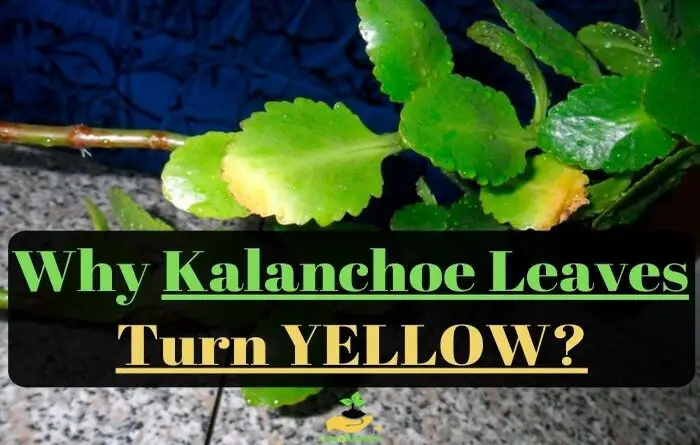8 Reasons Why Kalanchoe Leaves Turn Yellow (& What to Do)
Kalanchoe is both a medicinal and ornamental plant that can decorate the windowsill of any apartment. This home flower is also beneficial in that it has a simple care that any plant lover can handle, even a beginner. But there are situations when yellow leaves appear on the Kalanchoe plant.
This article will tell you why Kalanchoe leaves turn yellow, and how to avoid their appearance.
| Causes of Yellow Leaves on Kalanchoe blossfeldiana: |
|---|
| 1. Waterlogging |
| 2. Excess or Lack of Lighting |
| 3. Improper Soil |
| 4. Small Flowerpot |
| 5. Lack of Nutrients (nutrient deficiency) |
| 6. Pest Attacks |
| 7. Unbalanced Temperature |
| 8. Natural Aging |
Causes of Yellow Leaves on Kalanchoe
Care for almost any variety of Kalanchoe is simple and does not require compliance with complex rules and regulations.
If Kalanchoe leaves begin to turn yellow and dry, there can be many reasons for this.
But there are situations when the plant begins to behave differently: the leaves dry (the lower or upper leaves most often turn yellow), the flower fades, the leaves fall off.
Yellowing occurs when there is little chlorophyll in the leaves and, therefore, the Kalanchoe plant cannot transform food into energy. This deficiency can be caused by a number of reasons like:
1. Waterlogging
Yellowing of Kalanchoe leaves is most often caused by overwatering(waterlogging), which leads to flooding of the roots. In this case, it is necessary to reduce watering, especially in winter, and allow the soil to dry out.
Kalanchoe does not require large amounts of water. It is sufficient if you moisten the soil once every 10 to 14 days. The accumulated water in the pot saucer should be removed after 15 minutes so that the plant does not stand in the water.
The Kalanchoe should not be watered when the leaves are drooping. This means that the soil is too wet and not too dry, many people mistakenly think.
This is the most common cause of yellowing of leaves. If you water too much, you can end up “drowning” the roots of the plant. Pay attention to the soil: if it is still damp, wait another day to water it.
A sufficient drainage layer should also be provided in the pot. In the bottom of the container, in which we will plant the Kalanchoe, pour about 2 cm thick layer of gravel, organic ceramsite or crushed ceramic. This facilitates water drainage and prevents water from being stored in the area of the Kalanchoe roots.
Irregular irrigation, i.e. long periods of drought and then overwatering with large amounts of water remaining in the plant saucer, also causes Kalanchoe leaves to turn yellow .
If you cannot provide the Kalanchoe with regular watering, you should opt for hydroponic irrigation. The pots are equipped with special water tanks, from which these long-flowering houseplants absorb water as needed. Installed water level indicators show us when to fill up with water.
Speaking of flowers, do you know what are the most popular Italian flowers?
2. Excess or Lack of Lighting
Both excessive light or lack of light affect Kalanchoe leaves. That why if Kalanchoe is placed in shady areas the leaves turns yellow and curl or dull-colored leaves. This occurs due to the reduced production of chlorophyll. The solution is to move the plants to a sunny area.
The kalanchoe plant needs a light spot in the house that should not be exposed to direct midday sun. A location on a windowsill facing east or west is ideal.
The kalanchoe appreciates the light, and direct sunshine does not bother it, except during the strong summer heat, the sun then burning the leaves turning them yellow. The plant will also appreciate a short stay in the garden at the end of spring and until the beginning of autumn, in a shaded position.
The kalanchoe requires sunlight to grow properly, 3 or 4 hours a day is more than enough. Make sure it does not receive direct sunlight, as too much sun rays can have negative consequences (leaf burns). If placing the kalanchoe indoors, try placing it in a bright window.
Kalanchoe likes a place with good lighting, although it can be grown in partial shade, as long as it receives direct sunlight for a few hours a day. To induce flowering, regulate the plant’s sun exposure so that it receives less than 12 hours of light a day.
3. Improper Soil
The solution to the problem of Kalanchoe yellow leaves due to improper soil is to find very permeable and rather lean soil. You can’t go wrong with a ready-mixed cactus substrate. If you prefer to mix it yourself, add just as much sand, clay granules or pumice gravel to normal potting soil .
Normal potting soil from the garden center is usually not ideal for Kalanchoe care. Mix your potting soil 50:50 with succulent soil . As a result, the roots are sufficiently aerated and excess water runs off faster.
Kalanchoe prefer loose, well-drained soil and regular fertilizer applications . A high-quality flower fertilizer with guano or a cactus fertilizer from March to August every 3 to 4 weeks is ideal. In this way, you can take good care of your flowering potted plants. The nutrients it contains are conducive to a rich abundance of flowers and good growth.
Very permeable substrates are recommended for cultivation. Cactus soil or sandy potting soil with expanded clay ensure water drainage and prevent harmful waterlogging.
If desired, you can prepare the soil yourself by mixing in equal proportions: peat; sod soil; sheet soil. Kalanchoe can be repotted once a year in rich, light soil, which can be supplemented with a little sand and clay pebbles, if the pot is large.
When the plant does not find enough iron in the soil because the pH of the soil does not match what the plant needs. Plants that are from acidic soil can absorb iron if the soil is acidic.
4. Small Flowerpots
The fourth cause for yellow leaves lies in the planting of the Kalanchoe flower. Yellowing of the leaves is one of the possible consequences of a cramped pot. Kalanchoe does not like large pots either.
Many choose the small pot because the roots of Kalanchoe are small, however, in a pot that is too small, it will be difficult for the rhizome to develop.
Repot the Kalanchoe in a spacious pot every year during the spring. Choose a pot that is 10% – 20% larger than the current pot.
We recommend adding hydro granules when repotting. So it doesn’t matter if you give too much water: the hydro granules provide drainage.
The flower grows and develops quickly. For good health, its roots need space: choose each new pot 2 centimeters wider than the previous one. Then the root system will develop properly.
Change the pot to a larger one every year, preferably in the last days of March. This should be done with caution: the trunk, shoots and leaves of the plant are quite fragile and can turn yellow because of the lack of drainage.
Place a drainage mixture at the bottom of the container when planting. A good option is expanded clay. It will regulate soil moisture and will not allow water to stagnate.
Is Lavender a Flower or a Herb? Find out the answer in this post!
5. Lack of Nutrients (nutrient deficiency)
A lack of minerals in the soil can also cause yellowing of Kalanchoe leaves. Kalanchoe is particularly sensitive to zinc deficiency in the soil. In the absence of this component, the veins between the leaves turn yellow, lose strength and become distorted.
To prevent zinc deficiency, the Kalanchoe should be planted in a soil rich in peat and perlite with a pH of 6.0 to 6.5. Ready-made substrate mixes suitable for growing cacti and succulents are available in flower shops.
All indoor flowers, due to growing in pots, need periodic feeding, as the earth tends to deplete. Fertilizing during the active growth phase will allow the flower not only to form beautiful buds, but also to fully eat.
Many of the causes that lead to yellowing of the leaves are linked to a poor supply of nutrients.
The first sign of a nutrient deficiency is the yellowing of the leaves. In such a situation, you only need to do one thing to fertilize.
Plants need 13 essential minerals to survive, so it’s important to keep your fertilization up to date. From April to September fertilize Kalanchoe every two weeks with a liquid fertilizer diluted in water.
One of the most frequent deficiencies concerns nitrogen , which is essential for the fruiting and vegetative growth of the plant.
In case of nitrogen deficiency, the leaves turn thin and yellow, the flowering and production decreases and the roots become noticeably thin.
6. Pest Attacks
Yellowing of the Kalanchoe leaves may be hiding behind an attack on the flower by pests such as aphids, mealybugs, scale insects.
The latter is dangerous because it introduces poison into the plant. The fight against scale insects is the simplest: it is enough to treat the plant with a solution of laundry soap. And the insect colony will be destroyed.
The most dangerous enemy of succulents is aphids. These small insects reproduce rapidly. Their colonies grow in a matter of days and are able to literally suck out all the juices and destroy the flower.
Mealybug is a more dangerous enemy of room flora. Its appearance will be prompted by small white lumps, similar to cotton wool, located on the ground, stem or foliage. Uninvited guests are washed with a cotton pad moistened with soapy water and alcohol.
You will have to process several times, changing the insecticide, as the parasite knows how to adapt to the drugs. The remains of the chemical agent can be poured into a pot to destroy the infection that has infected the soil.
If the root system is damaged, the Kalanchoe flower must be transplanted into a new soil. Before transplanting, the root is treated with an insecticide, the pot is thoroughly washed with hot water and treated with the same agent.
Another danger lies in the viruses carried by aphids. Infected stems and leaves are broken off and burned. Healthy ones are carefully treated with insecticides 4-5 times, with a difference of a week.
7. Unbalanced Temperature
A high or low temperature also leads to yellowing of the Kalanchoe leaves. Temperatures below + 10 °C will be fatal. From a long stay in the cold, Kalanchoe may die. Do not place it in a room with temperatures above 77°F (+ 25 °C). The heat also contributes to the yellowing of the leaves.
A normal temperature for kalanchoe should be between 60°F to 77°F (15°C to 25°C) so the flower can be taken out in the spring to the street or to the balcony, where it will be comfortable until autumn.
High temperatures can also be the culprit for yellowing leaves. Although the Kalanchoe looks healthy, its leaves turn yellow but do not dry. In addition, yellowing of the leaves may occur as a result of infection of the plant or the attack of harmful insects.
Most often this happens when the flower is placed close to heating devices. In winter, the leaves can suffer from dry hot air. The pot must be removed from the radiator and humidify the air.
If the tips of the leaves have dried up and turned yellow, the reason may lie in the dryness of the air. No matter how the flower loves dry air, in the heat or the heating season, the moisture level becomes critically low. This causes problems, in particular, yellowness and dryness of the leaf plates.
Stagnant air also does not reflect well on the appearance of Kalanchoe. This flower loves fresh air, so in warm weather it is recommended to take it out to the balcony or veranda.
8. Natural Aging
The final reason why the leaves dry and turn yellow can be determine by the natural processes of aging. In such a situation, nothing needs to be done, since you cannot go against nature. Usually, yellowing of the leaves does not occur massively and on sufficiently mature plants.
If your plant does not have any of the above problems, the cause of the color change in the leaves may be simpler than you think: natural aging. Plants are living beings and therefore, like everything that has life, they die.
Measures to prevent yellowing of leaves in Kalanchoe
The best prevention of yellowing leaves is competent care. Not only the general condition of the flower depends on it, but also resistance to diseases and pests. With proper cultivation, the possibility of attack by insects is practically excluded.
Basically, the prevention of yellowing leaves is as follows:
1.Control the sunlight. The lack of light or, on the contrary, the direct sun may be causing this problem. Especially in indoor plants, it is easy to change the pot and check if moving to a place with more shade or, on the contrary, with more light, manages to stop the process that turns the leaves of your plants yellow.
2. Maintain the correct temperature. Keep an average room temperatures of 65-80°F (18-27°C)
3. Create a watering routine. Watering should be done directly on the soil, avoiding wetting the leaves of the plants. During the summer water Kalanchoe two to three times a week, taking care to let the compost dry between watering’s. In winter, water it less, do it only when the substrate starts to dry out and do not let water accumulate, at the risk of causing the roots to rot.
4. Fertilize. It is recommended to fertilize the kalanchoe at least a couple of times a year. Use a fertilizer that encourages flowering and plant growth. If you don’t know or have doubts, go to a specialized garden center.
5. Try Pruning. Remove the flower buds from the plant once or twice in summer to encourage branching.
6. Check for diseases and pests. Kalanchoe is mainly attacked by rot, which leads to rotting of the leaves and trunk.
7. Choose the right location. Succulents are designed for warm temperatures and lots of sun. If they lack light, they may lose their leaves. This can be avoided with the right location.
8. Change the location The lack of light or, on the contrary, the direct sun may be causing this problem. Especially in indoor plants, it is easy to change the pot and check if moving to a place with more shade or, on the contrary, with more light, manages to stop the process that turns the leaves of your plants yellow.
Conclusion
In this article we have presented you the most common reasons why kalanchoe leaves turn yellow. Yellow leaves in Kalanchoe are not a dangerous problem, but require the attention of a grower.
Remember that special attention and care make all the difference to the health of your Kalanchoes. Proper care and timely removal of pests will help get rid of yellowed leaves.
Thus, adherence to planting technology, proper care and proper feeding will help to avoid yellowing of the leaves of the Kalanchoe and maintain its healthy appearance. And simple preventive measures, performed in a timely manner, will facilitate the cultivation of this flower.
Frequently Asked Questions
You can pick off the yellow leaves or cut them off with sanitized scissors . Unfortunately, the leaves are no longer turning green.
Kalanchoe blossfeldiana are conditionally suitable for the garden. Seasonal planting of bowls or balcony boxes is possible. It is important that the succulents are protected from rain and intense sunlight. At low temperatures, the otherwise dark green leaves turn an intense red. Temperatures below 15 degrees Celsius lead to growth arrest and reduced flowering.
The Kalanchoe stores water in its leaves and therefore needs little water. The surface of the substrate should always dry well between waterings. In addition, excess water in the saucer should be removed, as the succulent is sensitive to waterlogging.
A cut is not necessary, fading is removed regularly. Long shoots can be shortened, but Kalanchoe does not have to be pruned regularly.




